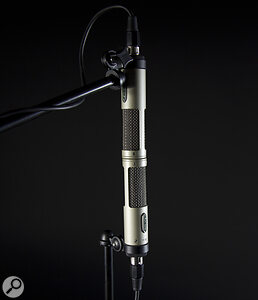In the first part of a new short series about Stereo Recording Techniques, we start by exploring the most important tools of all: your brain and your ears!
 Despite all the contemporary enthusiasm for multi‑channel immersive audio, most people still listen to recorded audio in stereo, and this obviously means that understanding and mastering stereo techniques remains a core skill for everyone involved in recording and mixing audio. Astonishingly, it’s been almost 30 years since I last wrote at length about stereo recording techniques in the pages of Sound On Sound! But, while it’s true to say that the principles haven’t changed in the intervening years, fashions and preferences certainly have — so I thought it about time I explored this topic once again, in a short series of articles over the next few months.
Despite all the contemporary enthusiasm for multi‑channel immersive audio, most people still listen to recorded audio in stereo, and this obviously means that understanding and mastering stereo techniques remains a core skill for everyone involved in recording and mixing audio. Astonishingly, it’s been almost 30 years since I last wrote at length about stereo recording techniques in the pages of Sound On Sound! But, while it’s true to say that the principles haven’t changed in the intervening years, fashions and preferences certainly have — so I thought it about time I explored this topic once again, in a short series of articles over the next few months.
Why Stereo?
Before we get into practical techniques and practices, the first questions we must ask ourselves are: why bother to record in ‘stereo’? Just what is it that we’re actually trying to achieve? I think there are two answers to these questions, and while both are perfectly valid they have very different goals and necessitate very different approaches.
The role of ‘stereo’ in most popular music is generally as ‘ear‑candy’, delivering exciting spacious effects. Often, it’s a case of the wider and more obvious the stereo spread, the better. Precise stereo imaging and accurate placement of sound sources within a real acoustic space is usually unnecessary, and often even irrelevant in this context (although there are exceptions, of course). Consequently, this ‘wider is better’ strategy brings enormous freedom in mic choices, placements and techniques. A practical example is miking an acoustic guitar with one mic placed close to the neck/body joint and another (often a different type of mic) near the tail of the guitar, with these two mics panned hard left/right, giving a wide stereo effect. The Glyn Johns drum recording technique is another example of (often) mismatched mics placed to deliver a pleasing and spacious ‘effect’ — even though precise imaging of individual drum components within the set, both relative to each other and within the acoustic environment, is largely lost.
The role of ‘stereo’ in most popular music is generally as ‘ear‑candy’, delivering exciting spacious effects. Often, it’s a case of the wider and more obvious the stereo spread, the better.
In contrast, recordings of classical music (and most other acoustic genres, in fact) tend to require a far more realistic portrayal of the relative spatial positions of instruments and performers, usually in a stage‑like setting, and within a natural acoustic environment. Achieving that necessitates precise and rigorous microphone techniques which, in turn, are built upon a good understanding of microphone properties and a knowledge of how parameters such as mic polar patterns, capsule spacing and mutual angle, mic height and distance all interact and can be adjusted to create the desired stereo imaging and perspective.
So, in this short series I shall be exploring a variety of popular stereo microphone techniques that are typically employed to achieve ‘realistic’ stereo recordings, as well as explaining how various practical tools and procedures can help to optimise these techniques and capture realistic stereo images — as might be employed for recording acoustic ensembles from duets to full orchestras, choirs, folk, jazz, ambient spaces, and more besides.
And for those immers‑o‑philes who might think stereo boring and old‑hat, it’s worth noting that the very concepts and techniques I’ll be discussing in relation to stereo recording can be expanded and enhanced for surround and immersive audio recording applications too!
...the very concepts and techniques I’ll be discussing in relation to stereo recording can be expanded and enhanced for surround and immersive audio recording applications too!
What Makes Stereo Stereo?
Before we move on, I think it’s helpful to consider, at least to a basic level, how our sense of hearing actually works, because the various stereo mic techniques are all designed to exploit one or more aspects of our hearing senses, and often they succeed or fail directly because of how they try to fool our senses.
Human hearing evolved, essentially, to warn us of impending danger located anywhere around us — the legendary sabre‑toothed tiger’s stealthy approach through the jungle, for example. Having made our brain aware of a potential danger, our hearing then provides sufficient extra information to enable the brain to turn the head to view that danger directly (the sense...
You are reading one of the locked Subscribers-only articles from our latest 5 issues.
You've read 30% of this article for FREE, so to continue reading...
- ✅ Log in - if you have a Digital Subscription you bought from SoundOnSound.com
- Buy & Download this Single Article in PDF format £0.83 GBP$1.49 USD
For less than the price of a coffee, buy now and immediately download to your computer, tablet or mobile.
- Buy & Download the FULL ISSUE PDF
Our 'full SOS magazine' for smartphone/tablet/computer. More info...
- Buy a DIGITAL subscription (or Print + Digital sub)
Instantly unlock ALL Premium web articles! We often release online-only content.
Visit our ShopStore.
